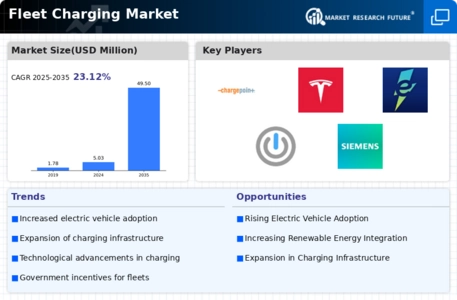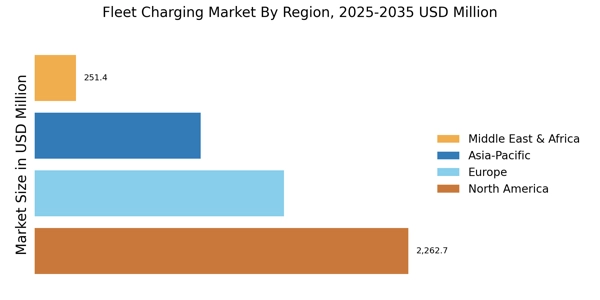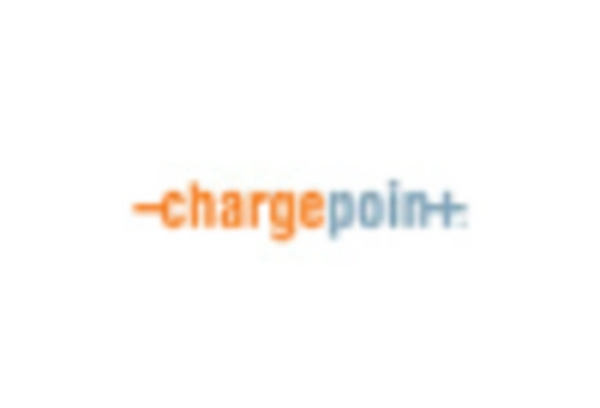Corporate Sustainability Initiatives
Corporate sustainability initiatives are increasingly influencing the Fleet Charging Market. Many companies are adopting sustainability goals that include reducing their carbon footprint and transitioning to electric fleets. In 2025, it is estimated that over 70% of Fortune 500 companies will have set ambitious sustainability targets, which often involve electrifying their transportation options. This shift not only aligns with consumer expectations for environmentally responsible practices but also offers potential cost savings in fuel and maintenance. As corporations invest in electric vehicles and the necessary charging infrastructure, the Fleet Charging Market is likely to benefit from this trend. The commitment to sustainability is driving demand for innovative charging solutions that support the electrification of corporate fleets.
Government Incentives and Regulations
Government incentives and regulations play a crucial role in shaping the Fleet Charging Market. Many governments are implementing policies aimed at reducing carbon emissions and promoting the use of electric vehicles. For instance, tax credits, rebates, and grants for electric vehicle purchases and charging infrastructure installation are becoming increasingly common. In 2025, it is projected that over 50 countries will have established stringent emissions targets, further driving the adoption of electric fleets. These regulatory frameworks not only encourage fleet operators to transition to electric vehicles but also stimulate investment in charging infrastructure. As a result, the Fleet Charging Market is likely to experience accelerated growth, driven by favorable government policies that support the electrification of transportation.
Increasing Demand for Electric Vehicles
The rising demand for electric vehicles (EVs) is a primary driver of the Fleet Charging Market. As consumers and businesses increasingly recognize the environmental benefits and cost savings associated with EVs, the market for electric fleets expands. In 2025, it is estimated that the number of electric vehicles on the road will surpass 30 million, leading to a corresponding increase in the need for efficient charging solutions. This surge in EV adoption necessitates the development of robust charging infrastructure, which directly impacts the Fleet Charging Market. Fleet operators are now prioritizing the transition to electric vehicles, thereby creating a substantial demand for advanced charging technologies and services. Consequently, the Fleet Charging Market is poised for significant growth as it adapts to meet the evolving needs of electric fleets.
Rising Fuel Prices and Operational Costs
Rising fuel prices and operational costs are compelling fleet operators to consider electric vehicles, thereby driving the Fleet Charging Market. As traditional fuel prices continue to fluctuate, many businesses are seeking alternatives that offer more predictable and lower operating expenses. In 2025, it is projected that the cost of gasoline will increase by 15% compared to previous years, prompting fleet operators to explore electric options. Electric vehicles typically have lower fuel and maintenance costs, making them an attractive choice for businesses looking to optimize their operational budgets. This economic pressure is likely to accelerate the transition to electric fleets, resulting in increased demand for charging infrastructure and services within the Fleet Charging Market.
Technological Advancements in Charging Solutions
Technological advancements in charging solutions are significantly influencing the Fleet Charging Market. Innovations such as ultra-fast charging stations, wireless charging, and smart grid integration are enhancing the efficiency and convenience of charging electric fleets. In 2025, the market for fast charging solutions is expected to reach USD 10 billion, reflecting the growing need for rapid charging options. These advancements not only reduce downtime for fleet vehicles but also improve the overall user experience. Furthermore, the integration of smart technologies allows for better energy management and optimization of charging schedules, which is essential for fleet operators. As these technologies continue to evolve, they are likely to drive further growth in the Fleet Charging Market, making it more attractive for businesses to adopt electric fleets.


















Leave a Comment